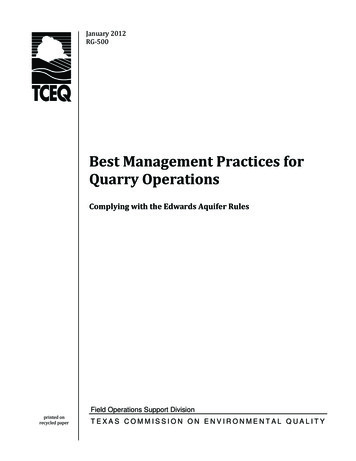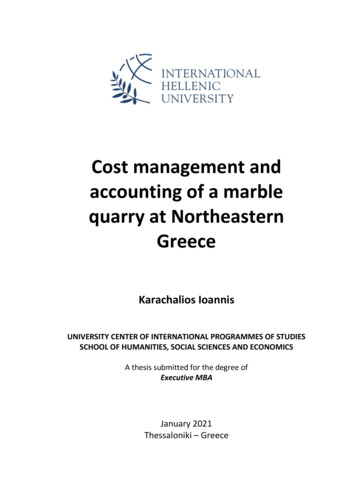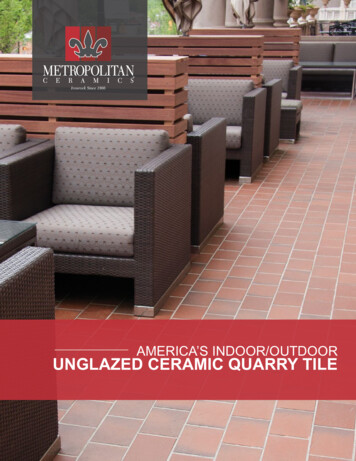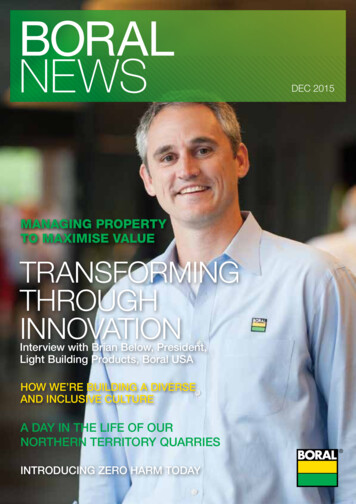
Transcription
January 2012RG-500Best Management Practices forQuarry OperationsComplying with the Edwards Aquifer RulesField Operations Support Divisionprinted onrecycled paperTEXAS COMMISSION ON ENVIRONMENTAL QUALITY
Best Management Practices for Quarry OperationsComplying with the Edwards Aquifer RulesField Operations Support DivisionTexas Commission on Environmental QualityPrepared byMichael E. Barrett, Ph.D., P.E.andBradley J. Eck, Ph.D., P.E.Center for Research in Water ResourcesBureau of Engineering ResearchUniversity of Texas at AustinRG-500January 2012
Bryan W. Shaw, Ph.D., ChairmanBuddy Garcia, CommissionerCarlos Rubinstein, CommissionerMark R. Vickery, P.G., Executive DirectorWe authorize you to use or reproduce any original material contained inthis publication—that is, any material we did not obtain from other sources.Please acknowledge the TCEQ as your source.Copies of this publication are available for public use through the Texas StateLibrary, other state depository libraries, and the TCEQ Library, in compliancewith state depository law. For more information on TCEQ publications call512-239-0028 or visit our website at:www.tceq.texas.gov/goto/publicationsPublished and distributedby theTexas Commission on Environmental QualityPO Box 13087Austin TX 78711-3087The TCEQ is an equal opportunity employer. The agency does not allow discrimination on the basis of race, color,religion, national origin, sex, disability, age, sexual orientation or veteran status. In compliance with the Americans withDisabilities Act, this document may be requested in alternate formats by contacting the TCEQ at 512-239-0028, Fax512-239-4488, or 1-800-RELAY-TX (TDD), or by writing PO Box 13087, Austin, TX 78711-3087.How is our customer service? www.tceq.texas.gov/goto/customersurveyii
ContentsHydrologic Design Levels by Document Section . vi1Introduction . 12General Guidelines. 22.1Separation from Groundwater in the Recharge Zone. 22.2Sensitive Features . 32.2.1Definition and Related Rules . 32.2.2Setbacks and Buffers for Sensitive Features . 42.2.3Sensitive Features Identified in the Geological Assessment . 52.2.4Sensitive Features Discovered During Quarrying . 62.2.5Inspection and Maintenance of Sensitive Features . 62.3Quarry Berms . 72.4Haul Roads, Parking Lots, and Tire Washes . 82.5Stream Crossings and Buffers . 82.6Dust Control . 92.7Mineral-Exploration Test Holes and Water Wells . 102.8Vehicle and Equipment Maintenance . 112.9Storage and Movement of Petroleum and Fuel . 122.9.1AST Facility Plan . 132.9.2Fueling Outside the Pit. 132.9.3Fueling of Equipment in the Pit . 132.10Industrial Facilities on-Site. 142.11Sanitary Wastewater Disposal . 142.11.1 Portable Toilet BMPs . 14January 2012iii
Best Management Practices for Quarry Operations2.12345TCEQ publication RG-500Spill Prevention and Control . 15BMPs for Areas Discharging to Surface Waters . 183.1Introduction . 183.2BMPs for Temporary Erosion and Sediment Control . 183.3Permanent Structural BMPs . 183.3.1General Requirements . 183.3.2Required Calculations . 19BMP Requirements for Areas within Quarry Pits . 194.1Introduction . 194.2Permanent Structural BMPs . 19Management of Process Water . 205.1.1Dimension-Stone Facilities (and Other Sites with Minor Water Use) . 215.1.2Innovative Technology for Aggregate-Production Facilities . 22References . 26Figures1. Concrete-lined sedimentation basins . 222. Large-scale sedimentation basin at aggregate quarry . 23Tables1. Reference-well water levels . 22. Precipitation intensity (in/hr) for various times of concentration for the 2-year storm . 93. Clay-liner specifications .124. Sample material inventory . 16ivJanuary 2012
TCEQ publication RG-500Best Management Practices for Quarry Operations5. Geotextile-fabric specifications .216. Example water balance for unlined sedimentation basins . 25January 2012v
Best Management Practices for Quarry OperationsTCEQ publication RG-500Hydrologic Design Requirements by Document SectionManagement PracticeHydrologic Design ThresholdDocument SectionHigh water level for purposesof setting quarry bottomelevationwater level in 12-month period withrainfall total at or above 90th percentile2.1Perimeter bermscontain 10-year 24 hour, spillway for100-year 24-hour2.3Culverts for stream crossings2-year event with duration equal to timeof concentration2.5Sedimentation ponds10-year 24-hour event plus 1 ft freeboard5viJanuary 2012
1 IntroductionQuarry operation is a regulated activity under the Edwards Aquifer rules (Title 30, TexasAdministrative Code, Chapter 213, or 30 TAC 213) and owners must apply to the TCEQ inorder to create or expand a quarry located in the recharge or contributing zone. An applicationfor development in the recharge zone is generically referred to as an Edwards Aquifer ProtectionPlan and consists of several plan types including a Water Pollution Abatement Plan. Anapplication for development on the contributing zone is referred to as a Contributing Zone Plan.This guide uses the term ―application‖ to refer to all of those plans.The potential impact on groundwater quality and water supplies from quarry operations in theareas subject to the Edwards Aquifer rules is a concern of many citizens and regulators.Quarrying requires substantial heavy equipment, equipment-maintenance areas, and refuelingoperations, and often includes associated facilities such as concrete or asphalt batch plants. Theact of removing rock reduces the separation between these activities and the water table, makingthe groundwater system much more vulnerable.Since 1999, quarry operators have developed applications following the guidelines inComplying with the Edwards Aquifer Rules (TCEQ publication RG-348). RG-348 was developedprimarily to address pollutant-reduction requirements for residential and commercial projects.Consequently, many of the recommended measures are not appropriate for quarry operations.This document is intended as a guide specifically for quarry operations; however, quarryoperators can seek variances, exceptions, or revisions based on site-specific facts.Quarries in the Edwards Aquifer include operations that produce dimension stone, aggregate,and sand and gravel. These quarries also come in a wide range of sizes. Dimension-stone andaggregate operations differ in the type of equipment employed, and in their water use and storagerequirements. In addition, some quarry operations are located in pit areas, where no surfacedischarges occur, while others have a substantial presence in areas where surface discharges dooccur. The latter include office areas, material stockpiles, parking lots, and retail-sales locations.This manual is divided into a chapters and sections. Chapter 2 covers general guidelines thatapply to all quarries and address elements such as perimeter berms, sensitive features, dustcontrol, stream crossings, maintenance and fueling facilities, spill response, and the operationof associated industrial facilities, such as batch plants. Chapter 3 recommends measures forimplementation in portions of quarries that discharge to surface waters, while Chapter 4 containsguidance for operations within the pit area. The manual concludes with Chapter 5, whichaddresses the management of process water on-site.January 20121
Best Management Practices for Quarry OperationsTCEQ publication RG-5002 General Guidelines2.1 Separation from Groundwater in the Recharge ZoneTo prevent pollution of groundwater in the Edwards Aquifer, the TCEQ recommends a minimumseparation of 25 feet between the quarry-pit floor and the groundwater level for quarries in therecharge zone. This distance is based on the maximum propagation of fractures from blastingoperation. The water level in the Edwards varies substantially across the area and with changesin rainfall. Consequently, the 25 ft separation should be maintained during even relatively wetyears. Analysis of historical rainfall records indicates that 9 out of 10 years have rainfall of lessthan 45 inches, and this has been selected as the critical rainfall depth.Determining the allowable quarry depth during the planning stages of development generallyrequires a preliminary estimate of the high-water level at the site. The best way to estimate thislevel is to use the water level measured in a water supply well or boring on-site for whichhistorical data are available. The TCEQ will accept the water-table elevation measured inDecember 2007 either on-site or in the nearest off-site well as the elevation from which the25 ft separation applies. If an off-site well is used, then the current water level on-site and in theadjacent well should be compared to determine whether to make any adjustments to account forregional variation in the water-surface elevation using the methodology outlined for a countyreference well. Abundant data on water surface elevations are available from the EdwardsAquifer Authority and the Barton Springs/Edwards Aquifer Conservation District.If nearby historical water-level data are not available the applicant may compare water level inan on-site well to certain reference wells located in each county. Easily accessible referencewells and their high-level water measurements are shown in Table 1. Water levels from otherwells, closer to the proposed quarry, may also be available from the Edwards Aquifer Authorityor Barton Springs/Edwards Aquifer Conservation District.When using a county reference well, an applicant should select the well located in the county ofthe proposed project, or the nearest well for locations in Travis or Comal county. The water levelin a well within the project boundary should be measured before submitting the application to theTable 1. Reference-well water levels.Reference WellHays [LR-67-02-104 (Kyle No. 2)]Bexar (J-17)MedinaUvaldeWilliamson (State well no. 5827305)2Wet-Weather High-Water Elevation(ft-msl)576691.4762.9882.5690January 2012
TCEQ publication RG-500Best Management Practices for Quarry OperationsTCEQ for review. This level should be compared to the level in the reference well made atapproximately the same date. The difference between the reference-well water level at that dateand the high-water level shown in Table 1 should be used to make an estimate of the differencebetween the on-site water level at the date of measurement and the anticipated water level ina wet year. Daily water levels of the Bexar, Median, and Uvalde wells are available at www.saws.org/our water/aquifer/ .Data from the well in Hays County are available from the U.S. Geological Survey.From the USGS Web page for groundwater data waterdata.usgs.gov/nwis/gw ,navigate to Daily Data and search for site number 295858097521801. Or accessthe data directly at nwis.waterdata.usgs.gov/tx/nwis/gwlevels?site no 295858097521801&agency cd USGS&format html .Data from the well in Williamson County are available from the Texas Water DevelopmentBoard. From the board‘s data Web page www.twdb.state.tx.us/data/data.asp , navigate to theGroundwater and Well Water section, and then to Williamson County and Water Level Table.Or visit terReports/GWDatabaseReports/GWdatabaserpt.asp .As an example, assume that an exploratory well on a proposed quarry location in Bexar Countyencounters groundwater at an elevation 580 ft above sea level. On approximately the same datethe elevation in the reference well (J-17) is found from the SAWS website to be 670 feet. Thedifference between the current elevation and the wet weather level is 21.4 feet. Consequently,the estimate for the preliminary high water level at the proposed quarry location would be21.4 580, or 601.4, feet. The quarry floor should be located a minimum of 25 ft above that,which means that the application should indicate a minimum pit-floor elevation of 626.4 ft.Quarries are typically in operation for many years and it is expected that the critical wet-yearrainfall depth will occur at some time during operation. The operator may make a staticmeasurement of the groundwater-surface elevation after 12 consecutive months with a totalrainfall of at least 45 inches. This on-site water elevation can then be used to revise the minimumpit-floor elevation in a modification of the application submitted to the TCEQ.These recommendations regarding separation from groundwater generally do not apply tosand and gravel operations, which may operate under saturated conditions. That is because thegroundwater encountered is not located within the Edwards Aquifer, but is usually a perchedwater table associated with the water level in an adjacent stream or river.2.2 Sensitive Features2.2.1 Definition and Related RulesSensitive features are defined in the Edwards Aquifer rules (30 TAC 213.3) as permeablegeologic or man-made features located on the recharge zone or transition zone where:January 20123
Best Management Practices for Quarry OperationsTCEQ publication RG-500 a potential for hydraulic interconnectedness between the surface and the Edwards Aquiferexists, and rapid infiltration to the subsurface may occur.Sensitive features comprise caves, solution cavities, solution-enlarged fractures, sinkholes, andother karst surface expressions that meet those two criteria.Sensitive features may be identified during the geological assessment or may be encounteredduring quarrying activities. Site planning must address sensitive features identified in thegeological assessment and any sensitive features may need special protection if located nearareas with pollutant sources such as where vehicle maintenance or fueling occurs or onsiteindustrial facilities are located.The rules require that Best Management Practices (BMPs) be implemented to ―prevent pollutantsfrom entering.sensitive features.‖ and ―maintain flow to naturally occurring sensitivefeatures.‖ [TAC 213.5(b)(4)(B) and TAC 213.5(b)(4)(C)]. The recommended practice forprotecting sensitive features is the provision of natural buffer areas as described in Subsection2.2.2. Features identified in the geological assessment and their buffers must be addressed in theapplication‘s site plan as described in Subsection 2.2.3. Even with a very thorough assessment,some sensitive features may be discovered while the quarry is operating. These features may beaddressed as described in Subsection 2.2.4. Finally, Subsection 2.2.5 describes recommendedinspection and maintenance procedures.2.2.2 Setbacks and Buffers for Sensitive FeaturesSensitive features resemble icebergs in that the surface expression often represents only afraction of the spatial extent of the feature that exists just below the soil profile. Because thesefeatures can accept recharge over a substantial area, treating runoff only within the depressionmay lead to degradation of water quality in the aquifer. Consequently, the best protection forthese features is a natural buffer area.In some cases where several sensitive features occur in close proximity, setbacks may be appliedcollectively or may overlap, as long as the minimum standard setback for each feature isretained. No stormwater conveyance systems (storm drains, roadside swales, etc.) that wouldbring runoff from outside the existing drainage area should have outfalls where the runoff wouldbe directed to a sensitive feature by the natural topography.A buffer in its natural state will typically be a combination of dense native grasses and forbs in amosaic of shrubs and trees. Native vegetation, particularly live oak trees, should be preservedwithin the catchment area of caves or sinkholes. Stemflow occurring along the branches andtrunks of large trees may enhance infiltration by channeling rainfall to the root zone (Thurow etal., 1987). The existing soil structure and vegetation are compatible with pre-existing rechargeconditions and should require little maintenance.4January 2012
TCEQ publication RG-500Best Management Practices for Quarry OperationsThe TCEQ recommends maintaining the buffers around a cave, sensitive feature, or group offeatures in a natural state to the maximum practical extent. This implies a construction-free zoneuntil the feature will be quarried.Temporary runoff-protection measures should be installed according to existingrecommendations (see TCEQ publication RG-348) during any construction activities within thedrainage area of the feature. Temporary erosion-control measures should be placed as near theconstruction as possible to minimize disturbance within the buffer zones and drainage areas.2.2.2.1 CavesFor a cave, the buffer is based on the cave footprint, defined as the horizontal or plan-view mapof the cave, projected up to the surface to show the area of the site underlain by cave passage.The projected surface, labeled cave footprint, should be delineated on the site geologic map andproposed site plan. If caves are identified during the geologic site assessment, maps showingscale or dimensions should be made of their extent, including their openings and subsurfaceextent and any associated sinkholes.The natural buffer around the cave should extend at least 50 feet in all directions around thedelineated cave footprint as well as any associated openings and sinkholes. Where the boundaryof the drainage area to the cave lies more than 50 feet from the footprint, the buffer shouldextend to the boundary or 200 feet, whichever is less.2.2.2.2 Other Sensitive FeaturesFor other sensitive features, the buffer is based on the drainage area, which often includes a welldefined bowl-shaped depression of a few feet to many yards across and which represents thelocal collapse zone over a subterranean cavity. The top of the sharp slope break present at theperimeter of such a collapse zone should constitute the edge of the feature for the purposes ofcalculating setbacks, since the steep slopes within such a bowl usually filter little or no water andthus cannot improve its quality.The natural buffer around a feature should extend a minimum of 50 feet in all directions. Wherethe boundary of the drainage area to the feature lies more than 50 feet from the feature, the buffershould extend to the boundary or 200 feet, whichever is less. Buffers that extend into areas wherepeople or equipment might stray should be fenced or surrounded with large boulders or othermeasures that allow drainage but deter access.2.2.3 Sensitive Features Identified in the Geological AssessmentSeveral outcomes for sensitive features will be specified in the geological assessment, such as: Establishment of a natural buffer (as described above) around the feature. Recharge to theaquifer is preserved and its water quality is protected.January 20125
Best Management Practices for Quarry OperationsTCEQ publication RG-500 Removal of the feature as part of quarrying. Permanent sealing of the feature to protect water quality (appropriate in certain cases).A key part of quarry planning and permitting is developing the site plan for inclusion in theapplication. Since the application‘s site plan must show ―areas of soil disturbance‖ and ―existingand finished contours‖ [30 TAC 213.5(b)(2)(B)], an approved application effectively serves asthe approved boundary of the quarry pit.When possible, avoid sensitive features when locating items outside the quarry pit. Whereextenuating circumstances exist and development over a sensitive recharge feature or itscatchment is proposed, the project owner can consider demonstrating that no feasible alternativesexist. Feasibility of alternatives should be based primarily on technical, engineering andenvironmental criteria. Feasibility should not be based predominantly on marketing or economicconsiderations or special or unique conditions resulting from the method by which the site planwas developed.Sensitive features not actively being mined should either be protected by a natural buffer orsealed to prevent infiltration. Natural buffers are recommended when proposed developmentssuch as haul roads or other facilities are located outside the buffer areas for such features.Features should be sealed when a significant incursion on the buffer area by a road or otherfacility is unavoidable.Where extenuating circumstances are approved by the TCEQ, the owner should providealternatives to make up for the loss of recharge to the aquifer, taking measures to ensure thatthe quality of enhanced or induced recharge is adequate to protect groundwater quality, and isconsistent with the requirements to protect ―improved sinkholes‖ in 30 TAC 331.2.2.4 Sensitive Features Discovered During QuarryingSome sensitive features are discovered during quarrying. The discovery of a new sensitivefeature must be reported to the TCEQ and work stops after protection for the feature is installed.The feature can be protected by removing the sediment from the adjacent area without disturbingthe feature, and installing a rock berm or other appropriate BMP around it to control and filterany potential flows into it. The work stoppage applies only to activities within the vicinity of thediscovered feature, and work is allowed to continue in other areas inside and outside the pit. Wallvoids with no surface expression and no drainage area are not considered sensitive. Thus,discovering a wall void during quarrying should not increase the risk of contamination and doesnot require notifying the TCEQ or stopping work.2.2.5 Inspection and Maintenance of Sensitive FeaturesSensitive features with buffer areas that extend into areas where people or equipment may bepresent should be inspected at least twice yearly. The inspection should verify that fencing orother barriers to deter access are in place and functional. The buffer itself should be inspected to6January 2012
TCEQ publication RG-500Best Management Practices for Quarry Operationsverify that no disturbance of the natural vegetation or soil has occurred as a result of human orvehicle activity.If the area has been disturbed, the perimeter fencing should be repaired and the area stabilizedand revegetated as soon as feasible. Use of fertilizers and pesticides should be minimized duringbuffer repair and only native vegetation used for stabilization.2.3 Quarry BermsOne way to meet pollution prevention goals is to use berms to prevent run-on of surface drainageinto a quarry pit by routing flow around it. Berms are also useful for creating a visual andphysical buffer between the quarry pit and adjacent property. Quarry operators should be awarethat capturing surface drainage in the quarry pit may violate of state water rights. In mostsituations, persons wishing to divert state water must receive prior authorization. State water isdefined as the water of the ordinary flow, underflow, and tides of every flowing river, naturalstream, and lake, and of every bay or arm of the Gulf of Mexico, and the stormwater, floodwater,and rainwater of every river, natural stream, and watercourse in the state. Appropriate measures,including perimeter berms, should be used to prevent any unauthorized diversion of state water.Consistent with TCEQ guidance for online facilities (RG-348), berm sizes should be based onthe 10-year, 24-hour storm and berms should be vegetated. An upgradient berm that captures anddetains upgradient flows should be designed with spillways to safely pass the volume associatedwith the 100-year, 24-hour duration into a quarry pit. Upgradient berms that simply direct runoffaround the pit do not require design and installation of a spillway. In sizing the berms, thecontributing drainage area and land cover should be considered. Detailed design of the bermsincluding required height, side slope, construction material, and compaction requirements shouldbe performed by a licensed engineer. Some surface drainage into the pit may be allowed inrestricted areas where the applicant can demonstrate that a berm would not be feasible.Earthen berms should be at least 2 feet wide at the top. The minimum height for earth bermsshould be 2 feet, with side slopes no steeper than 2:1. If vehicle crossings of the berm arenecessary, the crossings should have a slope of 3:1 or flatter and be armored with gravel.This design makes the berm last longer and strengthens the point of vehicle crossing.If a channel is excavated along the berm, it can be parabolic, trapezoidal, or V-shaped. Themaximum design flow velocity should range from 1.5 to 5.0 feet per second, depending on thevegetative cover and soil texture.Inspect earthen diversion berms quarterly to ensure continued effectiveness for the active life ofthe quarry. Inspections may be discontinued once all mining activity has ceased and equipmentremoved from the site, or once vegetation is established. Berms should be maintained to theiroriginal height with any decrease in height due to settling or erosion repaired in a timely manner.January 20127
Best Management Practices for Quarry OperationsTCEQ publication RG-5002.4 Haul Roads, Parking Lots, and Tire WashesBMPs should be implemented to prevent tracking of sediment onto adjacent highways and toreduce the generation of dust. Roads and parking areas for vehicles that will leave the site shouldbe paved. Additionally, roads leaving the site should be designed to force drivers to remain onthe pavement by the use of large boulders, railings, or other obstructions along the shoulder.Roads outside of the quarry pit should make use of BMPs as described in Chapter 3. Areas usedfor material stockpiles do not need to be paved, but should contain a system to remove mud anddirt from wheels of vehicles that have traveled on unpaved sections of the quarry except vehiclestraveling more than 1,000 ft on paved portions of the site before leaving the property.A rumble grate may be used to dislodge sediment from the wheels and undercarriage. Thisshould be placed at least 100 feet from a public road. A tire-wash system may be installed. Itshould be (1) located in front of some type of traffic restriction such as the quarry scale or a stopsign to encourage its proper use and (2) set back at least 300 feet from the public road. Thesystem should recycle water to minimize its use and prevent its discharge. Note that tire-washwater cannot be discharged to surface water or infiltrated through the quarry floor. Automatictire-wash systems are available from a variety of manufacturers.2.5 Stream Crossings and Buffer
Best Management Practices for Quarry Operations TCEQ publication RG-500 2 January 2012 2 General Guidelines 2.1 Separation from Groundwater in the Recharge Zone To prevent pollution of groundwater in the Edwards Aquifer, the TCEQ recommends a minimum separation of 25 feet between the quarry-pit floor and the groundwater level for quarries in the










